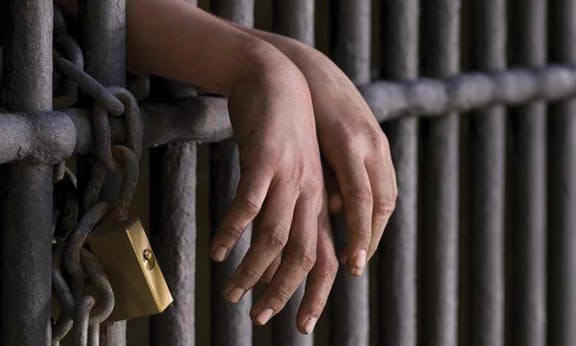Was Brighton killer’s anger fuelled by unjust imprisonment?

In the wake of the Brighton, Melbourne, siege, when lone gunman Yacqub Khayre killed a hotel worker and held a woman hostage in the name of ISIS and its rival al-Qaeda, the law and order hounds have been off the leash.
Australia has already passed some of the most extensive anti-terror legislation in the world. And it is set to become more draconian.
At the centre of the campaign is the further tightening of parole and bail laws. In Victoria, the “tough on crime” frenzy has already caused the parole system to be reviewed four times in the past five years. So the chest beating when it was revealed Khayre was on parole for a violent burglary was utterly predictable.
Numerous federal ministers attacked the Victorian judiciary for being “soft” on terrorism. In the lead-up to the Council of Australian Governments meeting, Malcolm Turnbull demanded to know “How was this man on parole?”
Not to be outdone, Victorian premier Dan Andrews declared that freedoms would have to be curbed. He even suggested that prisoners thought to have connections to terrorism should have their parole decision referred to ASIO and the Australian Federal Police.
At the COAG meeting, state governments agreed to adopt a presumption against parole and bail for people with demonstrated support for or links to terrorist activity.
But increasing incarceration rates – particularly for people who have not been convicted of a crime – only fuel the anger and hostility that lead to violence, political or otherwise.
Yacqub Khayre is a case in point. In 2009, Khayre was charged with helping to plot an attack on the Holsworthy Barracks in south-western Sydney. He was eventually acquitted, but before that he endured 16 months in “high security remand”, a facility holding mostly convicted violent offenders.
A leading human rights lawyer, Greg Barns, spelled out, in an article for Crikey, what that “hellish experience” looked like: “Constant strip searching, spending up to 23 hours a day locked in a prison cell, little access to mental health treatment and limited access to family and friends are the hallmarks of high-security units”.
Solitary confinement is a form of torture. The social isolation and lack of meaningful activity for extended periods cause significant psychiatric harm. And yet for those on remand, “once they are acquitted there is literally no support provided to them to readjust to civilian life”. Unsurprisingly, there is a strong correlation between recidivism and maximum security incarceration. As Barns argues:
“The fault lies with a corrections system that is obsessed with making prison life as unbearable as possible for certain types of remandees and convicted prisoners. It is a prison system that thinks it is acceptable to subject troubled young people to enduring isolation, boredom, capricious discipline and humiliation.”
Khayre isn’t the only terrorism suspect held in such conditions while awaiting trial.
Barns highlights a similar case: that of 12 men held in the high security Acacia Unit at Barwon Prison while awaiting trial on terrorism charges between 2005 and 2008. In that case, Supreme Court justice Bernard Bongiorno threatened to stop the trial, saying the conditions were “a risk to the psychiatric health of even the most psychologically robust individual”.
It’s not just terrorism suspects who are held in maximum security while on remand. The Victorian government had been holding 15 children, who were mostly on remand, in the Barwon maximum security adult prison after a riot in the Melbourne Youth Justice Centre in Parkville destroyed the facilities. Many of the children had not been involved in the riot or were not even in custody at the time.
In Barwon, these vulnerable children were held in solitary confinement for up to 23 hours for days on end. For the single hour they were let out of their cell, they were handcuffed and left alone. They were also denied access to registered educational programs, one of the few lifelines these kids have.
In March, children’s commissioner Liana Buchanan told the youth detention inquiry that one child’s limbs had been broken by “clumsy restraints”. She also reported that the commission is investigating allegations of assault by guards on nine children.
The government twice had to be ordered by the Victorian Supreme Court to remove the children from the adult prison for breaching their human rights – twice because the Andrews government sought to evade the first ruling by re-gazetting the Grevillea unit of the adult prison as a “youth detention centre”.
Desperate to look “tough on crime”, the Andrews government refused to apologise for disregarding the human rights of children and in February this year committed to spending $288 million on a new super-max youth prison.
Aggressive new bail laws have been central to the swelling of the prison population, which has increased by 38 percent over the past five years, according to the Australian Bureau of Statistics.
Between March 2012 and March 2017, the number of unsentenced prisoners has increased by an incredible 87 percent. One-third of people held in full time custody are on remand.
Not only are more people being denied liberty, but the overcrowding of jails also leads to less time out of the cell and a deterioration in access to services and resources. In New South Wales, where the prison population has surged by 16 percent in two years, two or three people are often held in a cell, with some sleeping on mattresses on the floor.
Predictably, the close confinement and lack of privacy create a hot house atmosphere, leading to a greater risk of violence. In NSW, according to the Bureau of Crime Statistics and Research, the assault rate per detainee has increased by 25 percent over the past two years. Brutalising inmates will do nothing to stop crime or further community safety. Indeed, 48 percent of NSW inmates are back behind bars within two years of release.